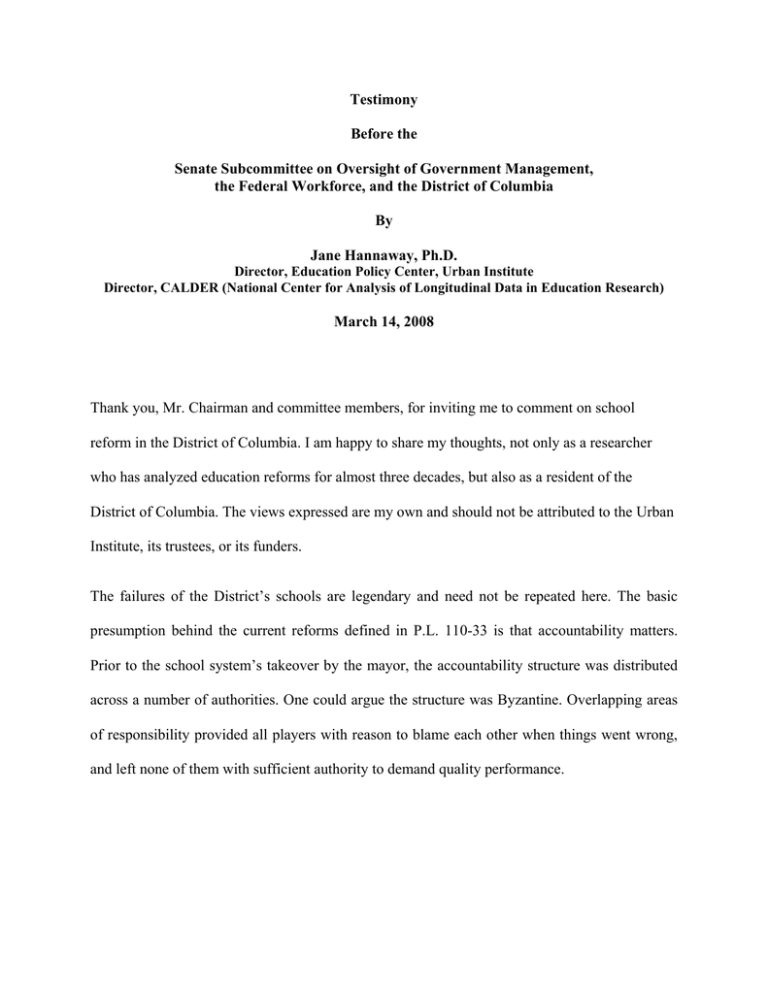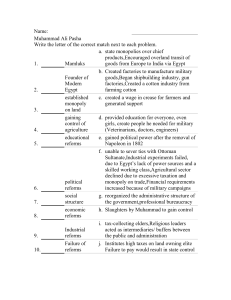Testimony Before the Senate Subcommittee on Oversight of Government Management,
advertisement

Testimony Before the Senate Subcommittee on Oversight of Government Management, the Federal Workforce, and the District of Columbia By Jane Hannaway, Ph.D. Director, Education Policy Center, Urban Institute Director, CALDER (National Center for Analysis of Longitudinal Data in Education Research) March 14, 2008 Thank you, Mr. Chairman and committee members, for inviting me to comment on school reform in the District of Columbia. I am happy to share my thoughts, not only as a researcher who has analyzed education reforms for almost three decades, but also as a resident of the District of Columbia. The views expressed are my own and should not be attributed to the Urban Institute, its trustees, or its funders. The failures of the District’s schools are legendary and need not be repeated here. The basic presumption behind the current reforms defined in P.L. 110-33 is that accountability matters. Prior to the school system’s takeover by the mayor, the accountability structure was distributed across a number of authorities. One could argue the structure was Byzantine. Overlapping areas of responsibility provided all players with reason to blame each other when things went wrong, and left none of them with sufficient authority to demand quality performance. Mayor Fenty should be applauded for his willingness to take responsibility for the schools. Reforming city schools is not for the faint of heart; the political costs can be high, and improved student achievement is not easily achieved. Success in schools will take more than governance changes. Governance reforms may help establish conditions necessary for the system to operate well. For example, recent actions in the District associated with special education, school closings, and reductions in staff may well promote system efficiency. But reforms closer to the classroom are necessary for better student learning. I would like to stress two areas in my comments: teacher quality and data systems. I see these two areas as closely related in basic and practical ways, as I explain below. I lead a national research center called CALDER, the National Center for the Analysis of Longitudinal Data in Education Research (http://www.caldercenter.org), funded by the U.S. Department of Education and headquartered at the Urban Institute. We use administrative data in a number of states, including North Carolina, Florida, and Texas, and New York, to analyze factors that promote student learning, especially the link between individual student success and teacher characteristics. The findings emerging on teacher effectiveness are stunning. Teachers are, by far, the most important school factor contributing to student achievement. Parents, principals, and other teachers have long known teachers can make a difference. But what is surprising is that the variation across teachers in effectiveness—as measured by students’ tested learning gains—is huge. The most effective teachers (top 15 percent) are about three times as effective as the least effective teachers (bottom 15 percent). Imagine the consequences for a student of having a highly effective, or a highly ineffective, teacher for several consecutive years. One study by a CALDER researcher estimates that if disadvantaged students had highly effective teachers for five years in a row, the achievement gap between the “haves” and the “have nots” would be closed. The difficult tasks for District of Columbia policymakers and education administrators are how to get more high-performing teachers in the classroom (especially classrooms serving the most disadvantaged students), how to hold teachers and schools accountable for student performance, and how to do it fairly. The answers are heavily dependent on good data systems. A big part of the problem in education is that the standard measures of teacher quality that are built into our current hiring practices and pay schedules—such as certification status, experience (beyond the first few years), and advanced degree (except in subject matter taught)—do not predict effectiveness in the classroom well. They simply do not distinguish more and less effective teachers. Many efforts are underway in the District and across the country to rethink how we train, select, assign and reward teachers to promote greater student learning. Increased reliance on new recruitment strategies, such as the New Teacher Project and Teach for America; new compensation and reward programs, such as pay for performance and National Board Certification; and new efforts to assign the best and the brightest teachers to schools where they are most needed are at the top of many state and local reform agendas. Implementing such reforms on a wish and a prayer, however, is not fair to school professionals and, most importantly, to students. Reforms that promote teacher effectiveness should no doubt be tried, but reforms should be guided by data systems that provide feedback on how well the reforms are doing and how they might be fine tuned. An important effort underway in the District of Columbia is a $25 million investment by the Office of the State Superintendent of Education for a longitudinal administrative data system that will enable the District to track student performance over time and to link the results to particular teachers. I have been serving on the panel reviewing proposals to develop the system, and I am very hopeful about the quality of the data system that will result. While administrative data systems cannot tell you everything about the effect of different types of teachers, programs, and policies on student achievement, a first-rate system can tell you much. Proper analysis is, of course, key since technical issues abound when estimating effects and it is important to get it right. Administrative data systems can also provide early warning signals to administrators and teachers about which teachers and students are in trouble and need support. If properly structured, such a system can provide ongoing feedback to individual teachers about the performance of individual students in their classrooms and thereby help guide instructional efforts. In addition, such information can help depoliticize what should be objective managerial decisions, based squarely on effects on student learning, about teacher policies, programs, and resource allocation. I suggest six specific recommendations for the District’s schools: • Be open to teacher candidates coming with non-traditional teacher training backgrounds, such as the New Teacher Project and Teach for America, as well as talented individuals in areas of teacher shortage, such as math and science. • Provide an intensive orientation and support structure, including performance feedback, for all new teachers for at least two years, regardless of their background. • Develop school, principal, and teacher performance incentive programs based on student learning gains. • Develop differentiated pay schedules to attract the best teachers to the most challenging schools and talented individuals in shortage areas. • Move the teacher tenure decision out to five years, rather than the current two years, so that the decision can be based on more information about teacher performance. • Encourage the involvement of objective professional analysts in research using the District’s administrative data and compare findings with other jurisdictions. To ensure their best use, the data should be protected from an overly conservative interpretation of FERPA (Federal Education Rights and Privacy Act) that has inhibited research in some states. In summary, when it comes to K-12 education, it is largely about teachers, teachers, teachers. The recommendations I offered need much detail before they could be effectively implemented, but the details right now are less important than the commitment to improve teacher performance and to let decisions be guided by objective information about what works.





